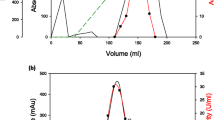Abstract
The cells ofLactobacillus amylovorus (NRRL B-4540), grown in a medium containing 2% cornstarch as the sole carbon source, secreted an amylase activity that rapidly solubilized cornstarch. Fourier transform infrared (FTIR) spectroscopic analyses showed that 80–90% of starch was consumed by bacteria in a 10-day-old culture medium. The remnant of starch granules digested in the culture medium inoculated with the cells ofL. amylovorus have also lost their characteristic iodine-binding capacity as visualized by starch dye-binding microplate assay and light microscopy. Scanning electron miscroscopy (SEM) of granules from a 48-h culture medium showed hollow and fragmented granules with a pitting phenomenon characteristically produced byα-amylase activity. Analysis of an enzyme preparation from a culture medium ofL. amylovorus revealed that the putative enzyme appears to be a single protein band of unusually high Mr (150,000) on SDS gels stained for amylase activity. Analysis of starch digestion products by thin layer chromatography (TLC) showed enzyme activity typical ofα-amylase.
Similar content being viewed by others
Literature Cited
Anderson KL, Salyers AA (1989) Biochemical evidence that starch breakdown byBacteroides thetaiotaomicron involves outer membrane starch-binding sites and periplasmic starch-degrading enzymes. J Bacteriol 171:3192–3298
Burgess-Cassler A, Imam SH, Gould JM (1991) High molecular weight amylase activities from bacteria degrading starchplastic film. Appl Environ Microbiol 57:612–614
Fitt LE, Snyder EM (1984) Photomicrographs of starches. In: Whistler J, Bemiller N, Pascall EF (eds) Starch: chemistry and technology, 2nd ed. New York: Academic Press, pp 675–689
Gallant D, Mercier C, Guilbot A (1972) Electron microscopy of starch granules modified by bacterial amylases. Cereal Chem 49:354–365
Giulian GG, Moss RL, Greaser M (1983) Improved methodology for analysis and quantitation of proteins of one-dimensional silver-stained slab gel. Anal Biochem 129:277–287
Goldner WR, Boyer CD (1989) Starch-granule-bound proteins and polypeptides: The influence of the waxy mutations. Starch/Stärke 41:250–254
Gould JM, Gordon SH, Dexter LB, Swanson CL (1990) Biodegradation of starch-containing plastics. In: Glass JE, Swift G (eds) Agricultural and synthetic polymers: biodegradability and utilization. ACS Symposium series No 433. Washington, DC: American Chemical Society, pp 65–75
Greenwell P, Schofield JD (1986) A starch granule protein associated with endoplasmic endosperm softness in wheat. Cereal Chem 63:379–380
Imam SH (1989) A tightly bound Mr 55000 polypeptide in cornstarch associated with the amylose portion of the granule. J Cereal Sci 9:231–236
Imam SH, Gould JM (1990) Adhesion of an amylolyticArthrobacter sp. to starch-containing plastic films. Appl Environ Microbiol 56:872–876
Imam SH, Greene RV, Griffin HL (1990) Adhesive properties of a symbiotic bacterium from a wood-boring marine shipworm. Appl Environ Microbiol 57:1317–1322
Koch VH, Ropper H (1989) New industrial products from starch. Starch/Stärke 40:121–131
Lacks SA, Springhorn SS (1980) Renaturation of enzyme after polyacrylamide gel electrophoresis in the presence of sodium dodecyl sulfate. J Biol Chem 255:7467–7473
Laemmli UK (1970) Cleavage of structural proteins during the assembly of the head of the bacteriophage T4. Nature (London) 227:680–685
Nakamura LK (1981)Lactobacillus amylovorus, a new starch-hydrolyzing species from cattle waste-corn fermentations. Int J Syst Bacteriol 31:56–63
Robyt JF (1984) Enzyme in the hydrolysis and synthesis of starch. In: Whistler J, BeMiller N, Pascall EF (eds) Starch: chemistry and technology, 2nd ed. New York: Academic Press, pp 87–122
Robyt JF, White BJ (1987) Chromatographic techniques. In: Robyt JF, White BJ (eds) Biochemical techniques: theory and practice. Brooks, California: Cole Publ Company, pp 107–109
Roper H, Koch VH (1988) New carbohydrate derivatives from biotechnical and chemical processes. Starch/Stärke 40:453–464
Shogren RL, Thompson AR, Greene RV, Gordon SH, Cote G (1991) Polymer compatibility and biodegradation of starchpoly(ethylene-co-acrylic acid)-polyethylene blends. J Appl Polymer Sci, “in press”
Tremoto Y, Kira I, Hayashida S (1989) Multiplicity and preferential inactivation by proteolysis as to raw starch-digestibility of bacterialα-amylases. Agric Biol Chem 53:601–605
Tsan-Piao, Spilatro SR, Preiss J (1988) Subcellular localization of amylases inArabidopsis leaf. Plant Physiol 86:251–259
Vihinen M, Mäntsälä P (1989) Microbial amylolytic enzymes. Crit Rev Biochem Mol Biol 24:329–418
Author information
Authors and Affiliations
Additional information
The mention of firm names or trade products does not imply that they are endorsed or recommended by the U.S. Department of Agriculture over other firms or similar products not mentioned.
Rights and permissions
About this article
Cite this article
Imam, S.H., Burgess-Cassler, A., Cote, G.L. et al. A study of cornstarch granule digestion by an unusually high molecular weightα-amylase secreted byLactobacillus amylovorus . Current Microbiology 22, 365–370 (1991). https://doi.org/10.1007/BF02092156
Issue Date:
DOI: https://doi.org/10.1007/BF02092156




